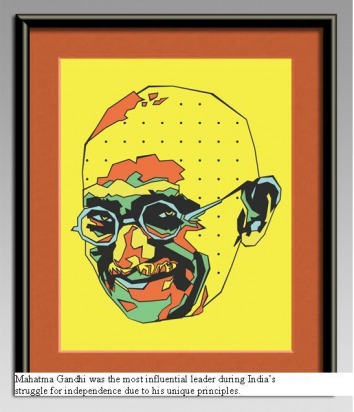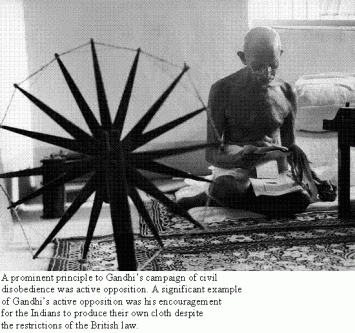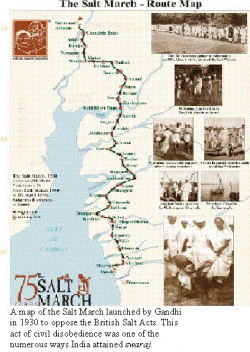The Principles of Satyagraha

As a result of the mismanagement of the East Indies Company, a revolt in 1857 known as the Sepoy Mutiny led to the establishment of the British Raj. Even though the British Raj brought order and stability to India, the cultural differences and the racial discrimination displayed by the British to the Indians ignited the desire of India to attain swaraj. The most influential figure during India’s independence struggle was Mohandas Karamchand Gandhi, more commonly known as Mahatma Gandhi. “Mahatma Gandhi was born on October 2, 1869, at Porbandar, a city in British-ruled western India” (Mohandas Gandhi). In 1888, Gandhi was sent to Great Britain so that he could attend law school, he returned to India in 1891 to open a legal practice. In 1893 Gandhi accepted a job to be a lawyer in South Africa, this was not a problem since British law governed South Africa. Gandhi’s South African experience, such as witnessing cultural differences and racial discrimination, proved momentous due to Gandhi’s development of his principles and philosophies to attain swaraj. These principles and philosophies would have a drastic impact not only on India, but also the world. Although the principles, nonviolence and swadeshi, of Gandhi’s concept, satyagraha were significant to South Asia’s Independence struggle, civil disobedience proved the most effective.

Even though Gandhi’s principle of civil disobedience was the most effective in South Asia’s independence struggle, the principle of nonviolence in Gandhi’s concept, satyagraha proved to be almost as effective. Although Gandhi was the creator of the concept, satyagraha, he did not create the principle of nonviolence. However, he was the first to apply this principle in order to achieve a political goal, in this case South Asian independence. Gandhi adopted this principle from Hindu sources, however as a result of his religious tolerance, Christian ethical literature strengthened his principal of nonviolence. For instance, a significant Bible verse in the book of Mathew “Do not resist an evil person. If someone strikes you on the right cheek, turn to him the other also” (NIV 1540) strengthened his principle of nonviolence. Gandhi transformed this Bible verse into a solution for attaining South Asian independence by advocating if one “turned their other cheek”, then overtime the enemy has no choice other than to respect this person for their self control. Gandhi rejected the traditional dichotomy between one’s own side and the enemy. He believed that India should explicate the injustice of the British Raj, and not fight them with violence, in this way India would obtain independence. However, in order for India to explicate the injustice of the British Raj through nonviolence, the people of India will have to risk their lives. For instance, Gandhi expressed that, “For this cause I am prepared to do. But there is no cause for which I am prepared to kill”. Therefore, through his faith in Hinduism and religious tolerance, Gandhi was able to apply the principle of nonviolence to his concept of satyagraha, which led India to independence and influential movements in our world today.
The second principle, the principle of swadeshi or active oppostion, of Gandhi’s concept, satyagraha, was significant to the achievement of South Asian independence. Swadeshi is a political movement in British India advocated by Mahatma Gandhi that displays active opposition. Due to Gandhi’s faith in Hinduism, he was able to adopt the principle of active opposition from the Bhagavad Gita, his “spiritual dictionary”. Gandhi was able to transform this principle from the Bhagavad Gita into a method for gaining South Asian independence by applying the principle of swadeshi to his concept, satyagraha. Gandhi demonstrated and encouraged active opposition with nonviolence to all of the British laws he deemed as unjust, such as the Rowlatt Acts. For instance, “Gandhi told his people: “Don’t pay your taxes or send your children to an English supported school” (Spielvogel 832). Gandhi also greatly advocated the active opposition to British made goods, especially cloth. Due to the British desire to control the production of cloth, the Indians were forbidden to produce their own cloth. As a result, Gandhi demonstrated active opposition to this outrageous law by encouraging his fellow companions to produce their own cotton cloth by spinning the thread at home. Gandhi’s application of the principle of active opposition or swadeshi, eventually proved to be effective through the result of South Asian independence.

In South Asia’s independence struggle from the British Raj, Gandhi’s principle of civil disobedience, refusal to obey laws considered to be unjust and then enduring the consequences, proved to be the most effective method for gaining swaraj. Gandhi used his principles of nonviolence and active opposition to characterize his principal of civil disobedience. For instance, Gandhi proved that peaceful rebellions, such as boycotts, to the unjust British laws are more effective than resistance through force. Gandhi displayed peaceful rebellion in 1930 when he launched protest to oppose the British Salt Acts. “These laws made it illegal to prepare salt from seawater, which would deprive the British government of tax revenue from its monopoly on the sale of salt” (Spielvogel 833). Therefore in 1930, Gandhi walked to the sea on what was known as the Salt March, with numerous supporters. “On reaching the coast, Gandhi picked up a pinch of salt. Thousands of Indians followed his act of civil disobedience” (Spielovogel 832). By taking a nonviolent and active approach to the laws he deemed as unjust, overtime Gandhi was able to control the actions of the British, “they are not in control, we are, that is the strength of civil disobedience”. Therefore with the principles of nonviolence and active opposition, Gandhi was able to develop his principle of civil disobedience, which proved to be the most effective in South Asia’s independence struggle.
Although it is still believed in our world today that resistance by force is the most effective method to achieve independence, Gandhi proved that through nonviolence, active opposition, and civil disobedience, independence can be achieved. Many groups struggling to achieve independence, such as the Civil Rights Movement in the United States have adapted the principles and tactics employed by Gandhi to gain South Asian independence. Therefore, through his principles of nonviolence, active opposition, and civil disobedience, Gandhi was able to achieve his goal, South Asian independence and his principles and philosophies continue to influence people today.
Bibliography
"Mohandas
Gandhi." World History: The Modern Era. 2009. ABC-CLIO. 3. Apr.
2009
<http://www.worldhistory.abc-clio.com>.
"Satyagraha." Encyclopædia Britannica.2009.
Encyclopedia Britannica Online School Edition. 3. Apr. 2009
<http://school.eb.com/eb/article-9065872>.
Spielvogel, Jackson J. World History. New York: McGraw-Hill Companies, 2008.
